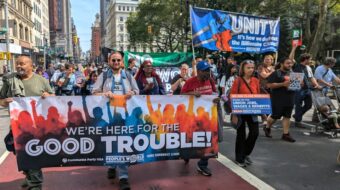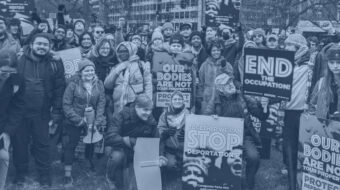On Oct. 7, 2001, the U.S. began bombing Afghanistan in response to the Sept. 11 terrorist attacks. Afghanistan was the country headed by a reactionary government called the Taliban, which also was allegedly giving aid and comfort to terrorist Al Queda boss Osama bin Laden. The bombing of Afghanistan and routing of the Taliban from power was supposed to bring liberation to a terribly impoverished people and war-torn country. U.S. occupation and military operations continue two years later.
Despite promises made by both President George W. Bush and British Prime Minister Tony Blair that Afghanistan will not be forgotten, human rights, economic vitality and other necessities of a democratic society have been.
Reports paint a dismal picture of life for people in Afghanistan.
In a devastating account called, “What Good Friends Left Behind,” journalist and film maker John Pilger wrote about Afghanistan – two years later, in the Sept. 20 British Guardian.
Pilger, who traveled to Afghanistan recently, describes the daily horrors:
“It was my first visit. In a lifetime of making my way through places of upheaval, I had not seen anything like it. Kabul is a glimpse of Dresden post-1945, with contours of rubble rather than streets, where people live in collapsed buildings, like earthquake victims waiting for rescue. They have no light and heat; their apocalyptic fires burn through the night. Hardly a wall stands that does not bear the pock-marks of almost every caliber of weapon. Cars lie upended at roundabouts. Power poles built for a modern fleet of trolley buses are twisted like paperclips. The buses are stacked on top of each other, reminiscent of the pyramids of machines erected by the Khmer Rouge to mark Year Zero.”
Pilger quotes earlier Guardian reports that up to 8,000 Afghans have been killed by U.S. bombs and as many as 20,000 more have died “as an indirect consequence of Bush’s invasion, including those who fled their homes and were denied emergency relief in the middle of a drought.”
Four U.S. soldiers have been killed in the last two weeks. In all, 35 U.S. soldiers have been killed in action in Afghanistan, and 162 wounded.
On Sept. 7 Bush requested $11 billion more for military operations in Afghanistan and a mere $800 million for reconstruction, half of which is for Afghan military and police. More than $10 billion has already been spent on Afghanistan since Oct. 7, 2001, according to Pilger.
“More than 80 percent of this has paid for bombing the country and paying the warlords, the former mojahedin who called themselves the ‘Northern Alliance,’” Pilger wrote.
No one knows what more misery this $11.8 billion more will buy.
Pilger describes another daily horror – land mines. “A hundred yards away, men in blue move stiffly in single file: mine-clearers. Mines are like litter here, killing and maiming, it is calculated, every hour of every day. Opposite what was Kabul’s main cinema and is today an art deco shell, there is a busy roundabout with posters warning that unexploded cluster bombs ‘yellow and from USA’ are in the vicinity. Children play here, chasing each other into the shadows. They are watched by a teenage boy with a stump and part of his face missing. In the countryside, people still confuse the cluster canisters with the yellow relief packages that were dropped by American planes almost two years ago, during the war, after Bush had prevented international relief convoys crossing from Pakistan,” he wrote.
The post-Taliban government is non-existent. U.S.-approved, Afghan President Hamid Karzai cannot go anywhere without his U.S. Special Forces bodyguards.
The country is run by “Mafiosi” or organized crime bosses, often termed war lords, placed in power by the U.S. They rule “by fear, extortion and monopolizing the opium poppy trade that supplies Britain with 90 percent of its street heroin,” Pilger said.
Pilger continues, “In a series of extraordinary reports, the latest published in July, Human Rights Watch has documented atrocities ‘committed by gunmen and warlords who were propelled into power by the United States and its coalition partners after the Taliban fell in 2001’ and who have ‘essentially hijacked the country.’ The report describes army and police troops controlled by the warlords kidnapping villagers with impunity and holding them for ransom in unofficial prisons; the widespread rape of women, girls and boys; routine extortion, robbery and arbitrary murder. Girls’ schools are burned down. ‘Because the soldiers are targeting women and girls,’ the report says, ‘many are staying indoors, making it impossible for them to attend school [or] go to work.’”
All of which leads to the question: If Iraq is a quagmire, what is Afghanistan?
To read Pilger’s full story go to www.guardian.co.uk.









